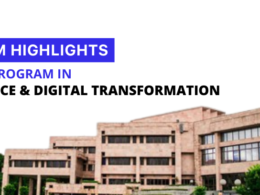Are you a Business Analyst eager to take your career to new heights? Do you aspire to become a data scientist and unlock the power of algorithms in your data-driven decision making? Look no further!
In this blog, we will explore the exciting journey from being a Business Analyst to a Data Scientist, and provide you with valuable insights on how to navigate this transition successfully.
Data science has become a rapidly evolving field with immense potential in today’s digital era. It involves the use of advanced analytics, machine learning, and artificial intelligence to extract insights from data and make informed decisions.
Business Analysts, with their strong analytical skills and domain expertise, are well-positioned to make this transition and leverage their existing knowledge to become Data Scientists.
From Insights to Algorithms: Navigating the Business Analyst to Data Scientist Transition
So, how can you navigate this transition and unlock the world of Data Science? Let’s dive in!
1. Enhance Your Technical Skills
As a Business Analyst, you already have a solid foundation in data analysis and interpretation. However, to excel as a Data Scientist, you need to expand your technical skills. This includes gaining expertise in programming languages such as Python or R, statistical analysis, machine learning algorithms, and data visualization tools.
There are numerous online resources, tutorials, and courses available to help you build these skills, and you can also consider enrolling in a formal Data Science program to gain comprehensive training. Join Accredian here.
2. Gain Domain-specific Knowledge
As a Business Analyst, you are likely to have domain expertise in a particular industry or field. To become a successful Data Scientist, it is crucial to build on this domain-specific knowledge. This involves understanding the unique data challenges, industry-specific data trends, and relevant business problems.
By leveraging your existing domain expertise, you can develop data-driven solutions that are tailored to your industry, and this will set you apart as a Data Scientist with a niche skill set.
3. Acquire Data Wrangling and Visualization Skills
Data Scientists need to be proficient in data wrangling and visualization, as they spend a significant amount of time working with data in different formats, cleaning and preparing it for analysis.
Familiarize yourself with data manipulation techniques, data cleaning, data transformation, and data visualization tools such as Tableau or Power BI. These skills are essential for extracting meaningful insights from data and communicating them effectively to stakeholders.
4. Embrace Machine Learning
Machine learning is at the heart of data science, and it’s important for Business Analysts transitioning to Data Scientists to understand and apply machine learning algorithms.
Start by learning the fundamentals of machine learning, such as supervised and unsupervised learning, regression, classification, clustering, and feature engineering.
Gain hands-on experience by working on real-world datasets and implementing machine learning models. This will not only boost your technical skills but also demonstrate your ability to apply machine learning in solving business problems.

5. Build a Strong Portfolio
As a Business Analyst transitioning to a Data Scientist, it’s crucial to showcase your skills and expertise through a strong portfolio. Create projects that demonstrate your ability to work with data, apply machine learning algorithms, and derive meaningful insights.
This could include building predictive models, creating interactive visualizations, or solving real-world business problems using data-driven approaches.
A strong portfolio will serve as a tangible proof of your capabilities and help you stand out in the competitive job market.
6. Network and Collaborate
Networking is key to any career transition, and data science is no exception. Connect with other data scientists, attend industry events, join online forums, and participate in data science competitions to expand your network.
Collaborate with fellow Data Scientists on projects, exchange knowledge, and learn from their experiences. Networking and collaboration can open doors to new opportunities, provide valuable insights, and help you stay updated with the latest trends and advancements in the field.
7. Stay Updated with the Latest Tools and Techniques
Data Science is a rapidly evolving field with new tools, techniques, and methodologies emerging constantly. Stay updated with the latest advancements in the field by regularly reading blogs, attending webinars, and following industry influencers.
Familiarize yourself with popular data science tools such as TensorFlow, PyTorch, Scikit-learn, and Apache Spark, and stay updated with the latest techniques in deep learning, natural language processing, and other areas of data science.
This will keep you ahead of the curve and ensure that your skills remain relevant in the ever-changing Data Science landscape.
8. Develop a Problem-Solving Mindset
Data Scientists are problem solvers, and developing a problem-solving mindset is crucial for a successful transition from a business analyst to a data scientist. Approach problems with a structured and analytical mindset, break them down into smaller components, and use data-driven approaches to derive insights and solutions.
Learn to think critically, experiment with different approaches, and iterate on your solutions. Problem-solving skills are highly valued in the field of data science, and honing these skills will make you stand out as a capable Data Scientist.

9. Gain Practical Experience
Practical experience is invaluable in the field of data science. Look for opportunities to apply your skills in real-world projects, internships, or freelance work.
Hands-on experience will not only help you apply your theoretical knowledge but also build your confidence in tackling real-world data challenges.
It will also add credibility to your portfolio and demonstrate your ability to deliver tangible results using data-driven approaches.
10. Stay Committed and Persistent
Transitioning from a Business Analyst to a Data Scientist is not easy and requires dedication, commitment, and persistence. It’s important to stay motivated, keep learning, and keep pushing yourself to improve.
There may be challenges along the way, but with perseverance and determination, you can overcome them and achieve your goal of becoming a successful Data Scientist.
At Accredian, we understand the unique challenges and opportunities of this transition, and our cutting-edge Data Science programs, in collaboration with E&ICT IIT Guwahati, are meticulously crafted to empower you with the expertise and proficiency needed to excel in this dynamic field.
So, what are you waiting for? Take charge of your future and make your mark in the world of data science. Join us at Accredian and start your transformation from insights to algorithms today!
Dive into our collection of Data Science resources for continuous learning. Don’t miss this opportunity! Join us today for an exhilarating journey toward a fulfilling career in Data Science! Let’s make your data-driven dreams a reality!
We hope you enjoyed reading this blog and found the insights valuable. If you have any questions or comments, feel free to reach out to us. Happy transitioning to a data scientist!





